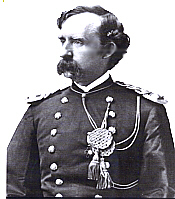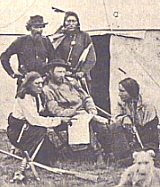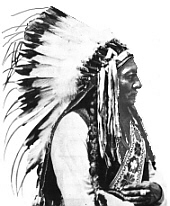 When crossing Montana, anyone interested in history
should stop at the Custer Monument and Battlefield.
Here, the central plains slowly give way to the
influence of the Rockies, just a little south of Billings
in the legendary Black Hills. The story of this
historic event begins many years prior to that fateful
date in June. In the 1860s, the white man’s
movement west had been all but stopped, as the great
Civil War raged in the East. But with the end of the
war came the relentless movement west of those
looking for a better life. Conflict was inevitable, as
Indians clashed with white men over the possession
of land.
When crossing Montana, anyone interested in history
should stop at the Custer Monument and Battlefield.
Here, the central plains slowly give way to the
influence of the Rockies, just a little south of Billings
in the legendary Black Hills. The story of this
historic event begins many years prior to that fateful
date in June. In the 1860s, the white man’s
movement west had been all but stopped, as the great
Civil War raged in the East. But with the end of the
war came the relentless movement west of those
looking for a better life. Conflict was inevitable, as
Indians clashed with white men over the possession
of land.
 George Armstrong Custer was a graduate of the
West Point Military Academy, where he gained honor
and prestige as a horseman. He fought in the Civil
War, leading cavalry units to success after success.
He reached his glory at Gettysburg where he charged
directly into the feared cavalrymen of General Jeb
Stuart, turning the Confederates and winning the day.
Before the war’s end, Custer had gained the rank of
Major General. His flashy dress (consisting of
custom tailored uniforms) and dashing personality
was the talk of Washington reporters, as he and his
wife passed through the highest of circles in the
Capital.
George Armstrong Custer was a graduate of the
West Point Military Academy, where he gained honor
and prestige as a horseman. He fought in the Civil
War, leading cavalry units to success after success.
He reached his glory at Gettysburg where he charged
directly into the feared cavalrymen of General Jeb
Stuart, turning the Confederates and winning the day.
Before the war’s end, Custer had gained the rank of
Major General. His flashy dress (consisting of
custom tailored uniforms) and dashing personality
was the talk of Washington reporters, as he and his
wife passed through the highest of circles in the
Capital.
 With the war over there was little need or money
for professional soldiers. As a result, Custer found
himself having to accept a new position as Lieutenant
Colonel. He was then assigned to the North West to
join the last battles fought in the Continental United
States, known as the Indian Wars. In an attempt to
avoid war, in 1868, a treaty was signed in Fort
Laramie giving a permanent reservation in eastern
Wyoming to the plains Indians. Specifically, the
Cheyenne and the Lakota Sioux who were now being
lead by the legendary Sitting Bull.
In 1874, gold was discovered within that promised
land and the word quickly spread East. The Montana
gold rush was on, bringing prospectors and soon
afterward all those who make their living off the gold
seekers.
With the war over there was little need or money
for professional soldiers. As a result, Custer found
himself having to accept a new position as Lieutenant
Colonel. He was then assigned to the North West to
join the last battles fought in the Continental United
States, known as the Indian Wars. In an attempt to
avoid war, in 1868, a treaty was signed in Fort
Laramie giving a permanent reservation in eastern
Wyoming to the plains Indians. Specifically, the
Cheyenne and the Lakota Sioux who were now being
lead by the legendary Sitting Bull.
In 1874, gold was discovered within that promised
land and the word quickly spread East. The Montana
gold rush was on, bringing prospectors and soon
afterward all those who make their living off the gold
seekers.
 Sitting Bull found his options dwindling as
any further attempts to move west were met by hostile
Crow Indians already claiming those hunting grounds.
With no place to go and trouble on every side, the
decision was made. Indian strikes against the
invading miners, trappers and settlers increased until
the Army decided to round the Indians up. Without
really knowing whether the Indians would fight or
not, columns left from Wyoming, Montana and
Dakota, heading for Southeastern Montana where
Sitting Bull, Crazy Horse and other Chiefs were
gathered. Attached to one of those units was the U.S.
7th Cavalry commanded by Lt. Col. Custer. Hoping
to catch the Indians somewhere along the river,
Custer was ordered to approach the Bighorn from the
south. On the morning of June 25, 1876, Custer’s
scouts reported a large Indian village along the banks
of the Little Bighorn River. What happened next has
been discussed and debated for over a hundred years.
This is but one version.
What Custer did is far better known then why. It
is believed by some , that Custer’s original intention
was to capture all the Indian women and children
while the warriors were fighting elsewhere. The
warriors, faced with the loss of their wives and
children would surrender, thus ending hostilities.
From a point high on a ridge south of the Village,
Custer broke his 7th Cavalry, consisting of about 600
men on horseback, into three battalions.
Sitting Bull found his options dwindling as
any further attempts to move west were met by hostile
Crow Indians already claiming those hunting grounds.
With no place to go and trouble on every side, the
decision was made. Indian strikes against the
invading miners, trappers and settlers increased until
the Army decided to round the Indians up. Without
really knowing whether the Indians would fight or
not, columns left from Wyoming, Montana and
Dakota, heading for Southeastern Montana where
Sitting Bull, Crazy Horse and other Chiefs were
gathered. Attached to one of those units was the U.S.
7th Cavalry commanded by Lt. Col. Custer. Hoping
to catch the Indians somewhere along the river,
Custer was ordered to approach the Bighorn from the
south. On the morning of June 25, 1876, Custer’s
scouts reported a large Indian village along the banks
of the Little Bighorn River. What happened next has
been discussed and debated for over a hundred years.
This is but one version.
What Custer did is far better known then why. It
is believed by some , that Custer’s original intention
was to capture all the Indian women and children
while the warriors were fighting elsewhere. The
warriors, faced with the loss of their wives and
children would surrender, thus ending hostilities.
From a point high on a ridge south of the Village,
Custer broke his 7th Cavalry, consisting of about 600
men on horseback, into three battalions.
